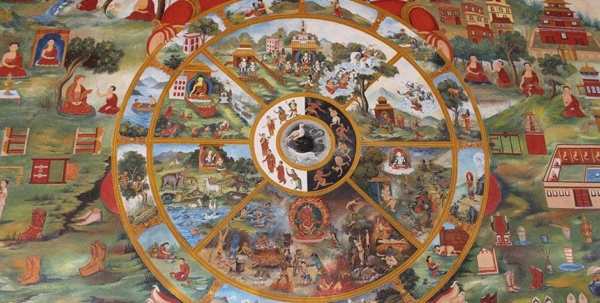
Wheel of Life: A Device to Teach Buddhism
The Buddha was the great teacher of humanity. He used many pedagogical tools, techniques, and devices to teach Buddhism. The Buddhist sutras, the parables and allegories in those Sutras, the tales of Jatakas have played educative roles. Various systems of symbols and signs are used as a codex to understanding the subtle teachings of the Buddha. The earlier teachings of the Abhidhamma come in the form of a matrix so that the mind could be systematically studied. The Buddha also gave a master list of what is called the 37 wings of enlightenment. Such is the richness of educative devices available.
One symbol that often adorns the doors of Buddhism in the Himalayas is the Wheel of life. The author has seen many wheels of life in the Himalayan Buddhist monasteries. There is a wheel of life depicted in the caves of Ajanta. This device is also known as the mirror of the mind.
This is how we can understand the basic teachings of the Buddha through this device.
In the innermost circle, the three animals representing three poisons are depicted: greed, hatred, and ignorance by a cock, a snake, and a pig. They are biting their tales meaning that these poisons are also interlinked. They need one another to emerge and sustain. The greed is the nature of mind when it indulges in the sensual pleasures, hatred is the nature of mind when it rejects something not pleasant, and ignorance is the blindness of mind and inability to experience the way it is. This is how we cyclically move again and again taking delight here and there.
The next concentric circle is divided into two halves: one half represents the path to progress and freedom and the other half represents mass delusion through the obnoxious culture and superstitions.
The third concentric circle is divided into different planes of consciousnesses that we all go through. We move through these planes of experiences in majorly six possible ways and their many variations. When we are in the happy realm with our all senses pleased, the Buddha reminds us of impermanence playing music. In the realm of competition and jealousy, even when we have what we need, we compete with others. In the realm of neurotic desire, we suffer. In the realm of dependency, we suffer helplessly. In the animal plane, we suffer due to limitations of animalistic consciousness. In the human plane, We suffer and remain oblivious to the possibility of enlightenment.
The fourth concentric circle is divided into 12 nidanas (links) of the dependent origination. It shows how different experiences arise out of ignorance and how they are created depending on the structure mind. It needs a longer discussion, we can reserve for the future.
The whole wheel is held by the ruthless impermanence. Everything within the wheel of life is changing and subject to transformation. The elements of the wheel of life are not fixed and they co- arise depending on each other and conditions.
The Buddha is shown pointing to the path that breaks this cyclic becoming and can take us to freedom that is boundless.
Author – Mangesh Dahiwale, Human Rights Activist



Well.very agreed